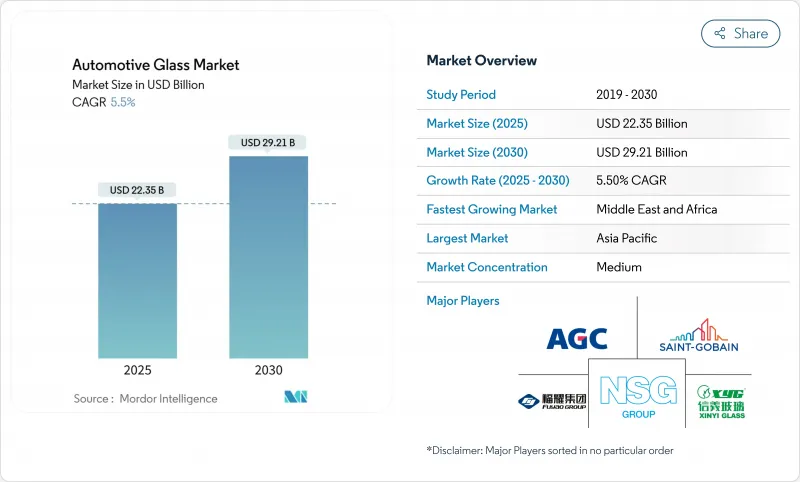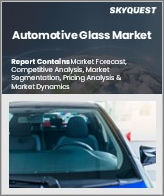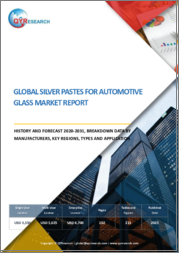
|
시장보고서
상품코드
1844576
자동차 유리 : 시장 점유율 분석, 산업 동향, 통계, 성장 예측(2025-2030년)Automotive Glass - Market Share Analysis, Industry Trends & Statistics, Growth Forecasts (2025 - 2030) |
||||||
자동차 유리 시장 규모는 2025년에 223억 5,000만 달러, 2030년에는 292억 1,000만 달러에 이를 것으로 예상되며, 예측 기간 중(2025-2030년) CAGR은 5.5%를 나타낼 전망입니다.

자동차 생산량 증가, 안전 의무의 엄격화, 전동 이동성으로의 전환은 원재료 가격과 물류 비용이 변동하는 가운데도 기세를 유지하고 있습니다. 파노라믹 루프, 경량 라미네이트 윈드스크린, 일렉트로크로믹 글레이징에 대한 수요가 증가함에 따라 제조업체는 전문 라인을 확대하고 OEM과의 파트너십을 강화할 수 있습니다. SUV에서는 유리면의 대형화가 중시되어 CO2 배출량 감축의 규제 압력과 함께 코팅 제품과 다기능 제품의 채용이 가속화되고 있습니다. 이러한 요인들이 결합되어 자동차 유리 시장은 향후 10년간 기술 주도로 견조한 성장을 이룰 것으로 보입니다.
세계의 자동차 유리 시장 동향과 인사이트
EV 플랫폼에서 파노라믹 유리로 이동
전기자동차 제조 업체는 자동차의 분위기와 브랜드 아이덴티티를 높이기 위해 더 큰 지붕 유리를 채택합니다. 테슬라의 Cybertruck과 메르세데스 벤츠의 Vision V 컨셉에는 색조 레벨을 조정하는 일렉트로크로믹 루프가 내장되어 있어 실내 온도를 최대 18°F 낮추어 공조 부하를 줄입니다. 차량 1대당 유리 면적은 급증할 것으로 예상되며, 공급업체는 광폭 굽힘 가공, Low-E 코팅, 적외선 흡수 중간막에 대한 투자를 촉진하고 있습니다. 이러한 프리미엄 사양은 생산비용 저하와 함께 중가격대의 EV에도 침투하여 자동차 유리 시장의 지속적 성장을 지원할 것으로 기대됩니다.
CO2 목표 달성을 위한 경량 맞춤 유리에 대한 OEM 수요
유럽의 규제는 2030년의 플리트 평균 CO2 배출량 목표를 100g/km로 설정하고 있어 자동차 제조업체는 1kg 단위의 삭감을 촉구하고 있습니다. 2017년 포드 GT의 EPA 조사에 따르면 합판유리는 질량의 30% 감소에 크게 기여했습니다. 이오노플라스트 중간막을 사용한 얇은 게이지의 라미네이트는 충격 성능을 저하시키지 않고 최대 30%의 경량화를 실현하고 있습니다. AGC와 산고반은 경량화와 제진성을 양립시킨 1.6mm의 윈드스크린을 상품화하고 있어 자동차 유리 시장의 장기적인 전망을 강화하고 있습니다.
특수 중간막(PVB, 이오노플라스트)공급 체인 크런치
클라레의 PVB 생산 능력 증강이 방음·HUD 그레이드 필름 수요 증가를 따라잡지 않고, 리드 타임이 연장되어 할당 프로그램을 강요당하고 있습니다. 유럽의 라미네이터는 스팟 공급 부족을 보고하고 애프터마켓 주문보다 OEM 생산을 우선해야 하는 상황에 있습니다. 바이오의 실험적 중간막은 53.1%의 유망한 기계적 이점을 제공하지만, 규모를 확장하는 데는 여전히 시간이 걸립니다. 단기적인 공급 스트레스는 새로운 공장이 일어날 때까지 자동차 유리 시장의 성장을 억제할 수 있습니다.
부문 분석
2024년 자동차 유리 시장 점유율은 비용 효율성과 생산 자산의 정착으로 보통 유리가 82.70%를 차지했습니다. 합판유리는 충격이 가해져도 파편이 흩어지지 않고 세계적인 안전 기준을 충족하기 위해 강화 유리에 비해 점유율을 늘리고 있습니다. 이 변화는 특수 중간막공급을 가혹하게 하지만 OEM이 더 얇고 가벼운 구조를 요구하기 때문에 라미네이터는 더 높은 가치를 얻을 수 있습니다. 스마트 유리는 현재 소수파이지만 CAGR 12.8%를 나타낼 것으로 예측되어 고급차와 하이엔드 EV의 틈새 시장을 개척하고 있습니다.
일렉트로크로믹 루프는 초기 채용이 주류이며 메르세데스 벤츠의 Vision V 프로토타입에 나타난 것처럼 부유 입자 디바이스(SPD)는 고속 스위칭과 내구성을 실현합니다. 폴리머 분산형 액정(PDLC) 윈도우는 프라이버시 파티션을 타겟으로 하고 있으며, 열변색 필름은 여전히 상업화 전입니다. 스케일 메리트가 향상됨에 따라 스마트 유리는 플래그십 모델 이외에도 확대되어 자동차 유리 시장을 강화하게 될 것입니다.
앞 유리는 2024년 자동차 유리 시장 규모의 44.60%를 차지하며 장착 의무화와 ADAS 센서 탑재율의 상승에 지지되었습니다. 복잡성은 단가를 밀어 올리고 공급업체와 OEM의 공동 개발주기를 강화합니다. 그러나 선루프는 SUV가 파노라마 뷰를 위해 큰 개구부를 표준화함에 따라 CAGR 10.2%로 가장 빠르게 성장하는 용도입니다.
백라이트는 어쿠스틱 라미네이트에 의해 완만한 견인력이 있지만, 보증의 문제가 스피드를 억제하고 있습니다. 사이드 라이트는 특히 유럽과 일본에서 돌출 방지법을 충족하기 위해 라미네이트 구조로 전환하고 있습니다. 백미러와 쿼터 윈도우는 일렉트로크로믹 방현 코팅을 통합하여 큰 면적을 필요로 하지 않는 기능을 추가하고 있습니다. 이러한 애플리케이션의 조합은 자동차 유리 시장의 꾸준한 확장을 지원합니다.
지역 분석
아시아태평양은 2024년 자동차 유리 시장의 49.20%를 차지하며 중국의 막대한 생산량과 급속한 국내 수요에 지지를 받았습니다. 정부의 장려책에 의해 공장의 생산 능력은 거의 유지되고 있어 인도의 생산량 증가가 새로운 수요축이 되고 있습니다. 상하이에서 개최되는 회의에서는 지능형 글레이징, LiDAR의 투명성, AR-HUD의 통합에 자리를 잡고 끊임없는 혁신을 소개합니다. 일본과 한국은 프리미엄 OEM용으로 선진적인 적층 유리 및 코팅 제품을 공급해 자동차 유리 시장 전체의 일부로서 이익률이 높은 틈새를 유지하고 있습니다.
생산자는 스마트 유리와 지속가능성 프로그램에 축발을 놓아 중국에서 수입품으로 인한 마진 압박에 대항하고 있습니다. AGC와 산고반의 공동 볼타로는 CO2 원단위를 줄이는 전략적 움직임을 보여줍니다. 한편 북미는 SUV 수요에 영향을 받고 있습니다. 미국에서는 애프터마켓이 활발하고 Auto Glass Now와 같은 브랜드는 전국적인 실적를 확대하고 교환 수요를 획득하고 있습니다.
중동 및 아프리카는 2030년까지 연평균 복합 성장률(CAGR)이 7.1%로 가장 빠르게 성장할 것으로 예측됩니다. 사우디아라비아의 실리카가 풍부한 광상은 현지 공급을 목적으로 플로트 유리 투자를 유치합니다. 보다 광범위한 산업 다양화의 의제에 따른 보조금은 자동차 부품 생산을 장려하고 이 지역의 자동차 유리 시장에서의 지위를 확대합니다. 남미 전망은 주로 브라질의 조립 대수와 관련이 있지만, 아프리카 성장의 중심은 남아프리카의 비교적 성숙한 부문입니다. 프록시미티(근접 생산) 전략은 세계 공급업체들이 이러한 다양한 지역 간의 운임 비용과 저스트-인-타임 기대치의 균형을 맞추는 데 도움이 됩니다.
기타 혜택 :
- 엑셀 형식 시장 예측(ME) 시트
- 3개월간의 애널리스트 지원
목차
제1장 서론
- 조사 전제조건과 시장 정의
- 조사 범위
제2장 조사 방법
제3장 주요 요약
제4장 시장 상황
- 시장 개요
- 시장 성장 촉진요인
- EV 플랫폼에서 파노라믹 글레이징으로의 변화
- CO2 목표 달성을 위한 경량 적응 유리에 대한 OEM 수요
- SUV에 선루프의 급속한 보급
- 규제에 의한 사이드 윈도우의 안전 유리 의무화
- 프리미엄 OEM에 의한 HUD 대응 프런트 유리 증가
- ADAS 기능을 위한 임베디드 센서 통합
- 시장 성장 억제요인
- 특수 중간막(PVB, 이오노플라스트)공급 부족
- 중국의 플로트 유리 생산 능력 과잉에 의한 EU 시장 침투 및 마진 침식
- SUV의 어쿠스틱 라미네이트 백라이트와 관련된 높은 보증 비용
- 성숙한 애프터마켓 채널에서 느린 교환 사이클
- 밸류체인 분석
- Porter's Five Forces
- 공급기업의 협상력
- 구매자의 협상력
- 신규 참가업체의 위협
- 대체품의 위협
- 경쟁 기업 간 경쟁 관계
- OEM과 애프터마켓의 동향 분석
제5장 시장 규모·성장 예측
- 유리 유형별
- 일반 유리
- 접합 유리
- 강화 유리
- 스마트 유리
- 전기변색 유리
- 현탁 입자 장치(SPD)
- 고분자 분산 액정(PDLC)
- 열변색 유리
- 일반 유리
- 용도별
- 윈드실드
- 백라이트(후면 창)
- 사이드라이트(측면 창)
- 선루프
- 후방 및 측면 미러
- 기타 유리(쿼터 및 벤트)
- 차종별
- 승용차
- 해치백
- 세단
- SUV 및 크로스오버
- 럭셔리 및 스포츠
- 소형 상용차
- 중대형 상용차
- 승용차
- 추진별
- 내연 엔진(ICE)
- 배터리 전기자동차(BEV)
- 하이브리드 전기자동차(HEV/PHEV)
- 연료전지 전기자동차(FCEV)
- 판매 채널별
- OEM
- 애프터마켓
- 지역별
- 북미
- 미국
- 캐나다
- 기타 북미
- 남미
- 브라질
- 아르헨티나
- 기타 남미
- 유럽
- 독일
- 영국
- 프랑스
- 스페인
- 이탈리아
- 러시아
- 기타 유럽
- 아시아태평양
- 중국
- 인도
- 일본
- 한국
- 호주
- 뉴질랜드
- 기타 아시아태평양
- 중동 및 아프리카
- 사우디아라비아
- 아랍에미리트(UAE)
- 남아프리카
- 기타 중동 및 아프리카
- 북미
제6장 경쟁 구도
- 시장의 집중도
- 전략적인 동향
- 시장 점유율 분석
- 기업 프로파일
- AGC Inc.(Asahi Glass)
- Saint-Gobain SA
- Nippon Sheet Glass Co. Ltd.
- Fuyao Glass Industry Group Co. Ltd.
- Xinyi Glass Holdings Ltd.
- Guardian Automotive(Koch Industries)
- Webasto SE
- Carlex Glass America LLC
- Magna International Inc.
- Vitro Automotive
- Corning Incorporated
- Sisecam Automotive
- Shanghai Yaohua Pilkington Glass
- Gentex Corporation
- AGP Group
제7장 시장 기회와 전망
KTHThe automotive glass market size stands at USD 22.35 billion in 2025 and is projected to reach USD 29.21 billion by 2030, reflecting a steady 5.5% CAGR during the forecast period (2025-2030).

Rising vehicle production, stricter safety mandates, and the shift toward electric mobility are sustaining momentum even as raw-material prices and logistics costs fluctuate. Growing demand for panoramic roofs, lightweight laminated windshields, and electrochromic glazing is encouraging manufacturers to scale specialized lines and deepen partnerships with OEMs. The emphasis on larger glass surfaces in SUVs, coupled with regulatory pressure to cut CO2 emissions, is accelerating the adoption of coated and multi-functional products. Together, these forces position the automotive glass market for resilient, technology-led growth through the decade.
Global Automotive Glass Market Trends and Insights
Shift Toward Panoramic Glazing In EV Platforms
Electric-vehicle makers are installing larger roof panes to enhance cabin ambience and brand identity. Tesla's Cybertruck and Mercedes-Benz's Vision V concept integrate electrochromic roofs that modulate tint levels, cutting cabin temperatures by up to 18°F and lowering HVAC loads. Glass area per vehicle is forecast to surge, prompting suppliers to invest in wide-format bending, low-E coatings, and infrared-absorbing interlayers. This premium specification is expected to permeate mid-priced EVs as production costs fall, supporting sustained growth in the automotive glass market.
OEM Demand For Lightweight Laminated Glass To Meet CO2 Targets
European regulations set a 100 g/km fleet-average CO2 goal for 2030, pushing automakers to shave every kilogram. EPA studies of the 2017 Ford GT show laminated glazing contributed materially to a 30% mass drop. Thin-gauge laminates using ionoplast interlayers now trim weight by up to 30% without compromising impact performance. AGC and Saint-Gobain are commercializing 1.6-mm windshield constructions that pair weight savings with acoustic damping, reinforcing long-term prospects for the automotive glass market.
Supply-Chain Crunch Of Specialty Interlayers (PVB, Ionoplast)
Kuraray's PVB capacity expansions have not kept pace with rising demand for acoustic and HUD-grade films, extending lead times and forcing allocation programs. European laminators report spot shortages, compelling them to prioritize OEM production over aftermarket orders. Experimental bio-based interlayers deliver promising mechanical gains of 53.1% but remain years from scale. Short-term supply stress may temper automotive glass market growth until new plants start up.
Other drivers and restraints analyzed in the detailed report include:
- Rapid Sunroof Penetration In SUVs
- Regulation-Led Mandatory Safety Glazing For Side Windows
- Margin Erosion From Chinese Float-Glass Overcapacity Flooding EU Market
For complete list of drivers and restraints, kindly check the Table Of Contents.
Segment Analysis
Regular glass commanded 82.70% of the automotive glass market share in 2024, thanks to cost efficiency and entrenched production assets. Laminated variants are gaining against tempered formats because they keep shards intact on impact, satisfying global safety norms. The shift tightens the supply of specialty interlayers, yet it positions laminators for higher value capture as OEMs demand thinner, lighter constructions. Smart glass, though only a minority today, is projected to post a 12.8% CAGR, carving out niches in luxury vehicles and high-end EVs.
Electrochromic roofs dominate early adoption; suspended particle devices (SPD) deliver faster switching and durability, as shown in Mercedes-Benz's Vision V prototype. Polymer-dispersed liquid crystal (PDLC) windows target privacy partitions, while thermochromic films remain pre-commercial. As economies of scale improve, smart glass will expand beyond flagships, bolstering the automotive glass market.
Windshields held 44.60% of the automotive glass market size in 2024, underpinned by mandatory fitment and rising ADAS sensor content. Complexity drives up unit value, reinforcing supplier-OEM co-development cycles. Sunroofs, however, are the fastest-growing application at 10.2% CAGR as SUVs standardize large openings for panoramic vistas.
Backlites see modest traction from acoustic laminates, though warranty issues temper speed. Sidelites transition to laminated construction to meet ejection-prevention laws, especially in Europe and Japan. Rear-view mirrors and quarter windows integrate electrochromic anti-glare coatings, adding feature content without large area demand. Collectively, the application mix underpins steady expansion in the automotive glass market.
The Automotive Glass Market Report is Segmented by Glass Type (Regular Glass and Smart Glass), Application (Windshield, Sunroof and More), Vehicle Type (Passenger Cars, and More), Propulsion (Internal Combustion Engine, Battery Electric Vehicle (BEV), and More), Sales Channel (OEM, and Aftermarket), and Geography. The Market Sizes and Forecasts are Provided in Terms of Value (USD).
Geography Analysis
Asia-Pacific dominated the automotive glass market, with 49.20% of the revenue in 2024, anchored by China's vast output and rapid domestic uptake. Government incentives have kept plants near capacity, while India's production climb adds a fresh demand axis. Conferences in Shanghai spotlight intelligent glazing, LiDAR transparency, and AR-HUD integration, showcasing continual innovation. Japan and South Korea supply advanced laminated and coated products for premium OEMs, preserving high-margin niches as part of the broader automotive glass market.
Producers combat margin squeeze from Chinese imports by pivoting into smart glass and sustainability programs. AGC and Saint-Gobain's joint Volta furnace evidences a strategic move to slash CO2 intensity. Meanwhile, North America remains influential due to the demand for SUVs. The United States features vibrant aftermarket activity; brands such as Auto Glass Now scale national footprints to capture replacement revenue.
The Middle East and Africa are expected to be the fastest climbers at 7.1% CAGR through 2030. Saudi Arabia's silica-rich deposits attract float-glass investments intended to localize supply. Subsidies aligned with broader industrial-diversification agendas incentivize auto-component production, broadening the region's stake in the automotive glass market. South America's outlook is tied chiefly to Brazilian assembly volumes, while Africa's growth centers on South Africa's relatively mature sector. Proximity production strategies help global suppliers balance freight costs and just-in-time expectations across these varied geographies.
- AGC Inc. (Asahi Glass)
- Saint-Gobain S.A.
- Nippon Sheet Glass Co. Ltd.
- Fuyao Glass Industry Group Co. Ltd.
- Xinyi Glass Holdings Ltd.
- Guardian Automotive (Koch Industries)
- Webasto SE
- Carlex Glass America LLC
- Magna International Inc.
- Vitro Automotive
- Corning Incorporated
- Sisecam Automotive
- Shanghai Yaohua Pilkington Glass
- Gentex Corporation
- AGP Group
Additional Benefits:
- The market estimate (ME) sheet in Excel format
- 3 months of analyst support
TABLE OF CONTENTS
1 Introduction
- 1.1 Study Assumptions & Market Definition
- 1.2 Scope of the Study
2 Research Methodology
3 Executive Summary
4 Market Landscape
- 4.1 Market Overview
- 4.2 Market Drivers
- 4.2.1 Shift Toward Panoramic Glazing In EV Platforms
- 4.2.2 OEM Demand For Lightweight Laminated Glass To Meet CO2 Targets
- 4.2.3 Rapid Sunroof Penetration In SUVs
- 4.2.4 Regulation-Led Mandatory Safety Glazing For Side Windows
- 4.2.5 Growing Retrofit Of HUD-Compatible Windshields By Premium OEMs
- 4.2.6 Integration Of Embedded Sensors For ADAS Functionality
- 4.3 Market Restraints
- 4.3.1 Supply-Chain Crunch Of Specialty Interlayers (PVB, Ionoplast)
- 4.3.2 Margin Erosion From Chinese Float-Glass Overcapacity Flooding EU Market
- 4.3.3 High Warranty Costs Linked To Acoustic Laminated Backlights In SUVs
- 4.3.4 Slow Replacement Cycles In Mature Aftermarket Channels
- 4.4 Value-Chain Analysis
- 4.5 Porter's Five Forces
- 4.5.1 Bargaining Power of Suppliers
- 4.5.2 Bargaining Power of Buyers
- 4.5.3 Threat of New Entrants
- 4.5.4 Threat of Substitutes
- 4.5.5 Intensity of Competitive Rivalry
- 4.6 OEM vs. Aftermarket Trend Analysis
5 Market Size & Growth Forecasts (Value (USD))
- 5.1 By Glass Type
- 5.1.1 Regular Glass
- 5.1.1.1 Laminated Glass
- 5.1.1.2 Tempered Glass
- 5.1.2 Smart Glass
- 5.1.2.1 Electrochromic
- 5.1.2.2 Suspended Particle Device (SPD)
- 5.1.2.3 Polymer Dispersed Liquid Crystal (PDLC)
- 5.1.2.4 Thermochromic
- 5.1.1 Regular Glass
- 5.2 By Application
- 5.2.1 Windshield
- 5.2.2 Backlite (Rear Window)
- 5.2.3 Sidelite (Side Windows)
- 5.2.4 Sunroof
- 5.2.5 Rear-view & Side-view Mirrors
- 5.2.6 Other Glazing (Quarter & Vent)
- 5.3 By Vehicle Type
- 5.3.1 Passenger Cars
- 5.3.1.1 Hatchback
- 5.3.1.2 Sedan
- 5.3.1.3 SUV & Crossover
- 5.3.1.4 Luxury & Sports
- 5.3.2 Light Commercial Vehicles
- 5.3.3 Medium and Heavy Commercial Vehicles
- 5.3.1 Passenger Cars
- 5.4 By Propulsion
- 5.4.1 Internal Combustion Engine (ICE)
- 5.4.2 Battery Electric Vehicle (BEV)
- 5.4.3 Hybrid Electric Vehicle (HEV/PHEV)
- 5.4.4 Fuel Cell Electric Vehicles (FCEV)
- 5.5 By Sales Channel
- 5.5.1 OEM
- 5.5.2 Aftermarket
- 5.6 By Geography
- 5.6.1 North America
- 5.6.1.1 United States
- 5.6.1.2 Canada
- 5.6.1.3 Rest of North America
- 5.6.2 South America
- 5.6.2.1 Brazil
- 5.6.2.2 Argentina
- 5.6.2.3 Rest of South America
- 5.6.3 Europe
- 5.6.3.1 Germany
- 5.6.3.2 United Kingdom
- 5.6.3.3 France
- 5.6.3.4 Spain
- 5.6.3.5 Italy
- 5.6.3.6 Russia
- 5.6.3.7 Rest of Europe
- 5.6.4 Asia-Pacific
- 5.6.4.1 China
- 5.6.4.2 India
- 5.6.4.3 Japan
- 5.6.4.4 South Korea
- 5.6.4.5 Australia
- 5.6.4.6 New Zealand
- 5.6.4.7 Rest of Asia-Pacific
- 5.6.5 Middle East and Africa
- 5.6.5.1 Saudi Arabia
- 5.6.5.2 United Arab Emirates
- 5.6.5.3 South Africa
- 5.6.5.4 Rest of Middle East and Africa
- 5.6.1 North America
6 Competitive Landscape
- 6.1 Market Concentration
- 6.2 Strategic Moves
- 6.3 Market Share Analysis
- 6.4 Company Profiles (includes Global level Overview, Market level overview, Core Segments, Financials as available, Strategic Information, Products & Services, and Recent Developments)
- 6.4.1 AGC Inc. (Asahi Glass)
- 6.4.2 Saint-Gobain S.A.
- 6.4.3 Nippon Sheet Glass Co. Ltd.
- 6.4.4 Fuyao Glass Industry Group Co. Ltd.
- 6.4.5 Xinyi Glass Holdings Ltd.
- 6.4.6 Guardian Automotive (Koch Industries)
- 6.4.7 Webasto SE
- 6.4.8 Carlex Glass America LLC
- 6.4.9 Magna International Inc.
- 6.4.10 Vitro Automotive
- 6.4.11 Corning Incorporated
- 6.4.12 Sisecam Automotive
- 6.4.13 Shanghai Yaohua Pilkington Glass
- 6.4.14 Gentex Corporation
- 6.4.15 AGP Group
7 Market Opportunities & Future Outlook
- 7.1 White-space & Unmet-need Assessment



















